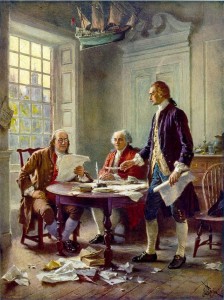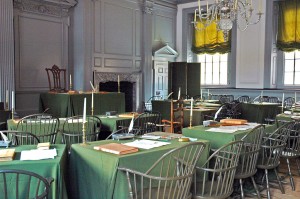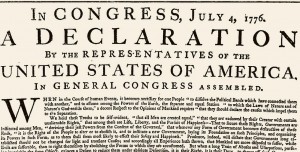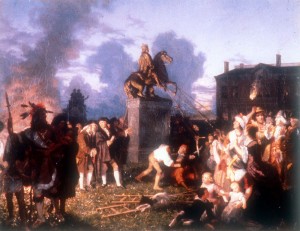It’s July 4th- Do You Know Your Revolutionary War Ancestors?

It was July 2, 1776 in hot Philadelphia, and a group of delegates to the Second Continental Congress had just committed a treasonous act- they had declared their thirteen American colonies as sovereign states, independent of Great Britain. That treasonous act included a unanimous vote for independence, using a document that had been drafted by a group of five, including Thomas Jefferson, the primary author.

Most of the delegates to the Continental Congress signed the document that same day, but it was not until July 4th that the remaining delegates approved the document that we now know as the Declaration of Independence. (Some historians believe it was not signed by all until August 2, 1776.)

The Declaration was read to the public on July 8th, 1776, accompanied by a parade of the battalions participating in the Revolutionary War, which had already been going on for over a year. Gun salutes were punctuated by cheers from the crowds who believed in the revolution. (I assume Loyalists were not in attendance… at least, not for long.)

John Adams, one of the instigators of revolution, wanted us to celebrate our independence on July 2nd. In a letter to his wife Abigail Adams, on July 3, 1776, he wrote:
“The second day of July, 1776, will be the most memorable epoch in the history of America. I am apt to believe that it will be celebrated by succeeding generations as the great anniversary festival. It ought to be commemorated as the day of deliverance, by solemn acts of devotion to God Almighty. It ought to be solemnized with pomp and parade, with shows, games, sports, guns, bells, bonfires, and illuminations, from one end of this continent to the other, from this time forward forever more.”
A large celebration did not occur until the first anniversary of the signing. In Philadelphia on July 4, 1777, fireworks, bonfires, 13-gun salutes from harbor ships, patriotic music, candles in the windows of houses, and church bells sang of our new country, and its promise that:
“We hold these truths to be self-evident, that all men are created equal, that they are endowed by their Creator with certain unalienable Rights, that among these are Life, Liberty, and the pursuit of Happiness.“

There are many Revolutionary War heroes in our family, and probably many more than we know. Wartime is particularly difficult when it takes place in ALL the areas that people live, as it did during the Revolution- few areas were spared from battles or troop movements. It was a brother vs. brother war as well, because so many of the colonists, including many of our ancestors, were native to England. Following are brief bits of info about three of our Revolutionary War heroes. More details about their lives will be found in upcoming posts.
Daniel-Hemphill (George A. Roberts) Family:
Capt. Audley Paul (1728-1802)- Born in Ireland, he served from 1754 in the French-Indian War through the close of the American Revolution. He was an Ensign in the Virginia Colonial Militia in 1758.
McMurray-Benjamin-Horn Family:
Jonathan Benjamin (1738-1841)- Private, received pension for his service from Licking County, Ohio.
Heinrich Horn (1758-1845)- Born in Germany, Heinrich has a very interesting story that will take a bit to tell in a future post. He did receive a Revolutionary War pension.
I do not know of any portraits of our own Revolutionary War ancestors- any who survived into the 1840s may have had their picture taken.
Time Magazine has a wonderful webpage, Faces of the American Revolution, that includes some portraits of Revolutionary War soldiers. Additionally, Maureen Taylor, “The Photo Detective,” has written two books that include similar portraits and the stories of these heroes: “The Last Muster: Images of the Revolutionary War Generation” (Vol. 1) and “The Last Muster. Vol. 2 Faces of the American Revolution.” Her article “Ghosts of the Revolution” about these 80+ year old soldiers was published in the DAR’s American Spirit magazine. She also had a Kickstarter campaign that raised money to make these books into a film, “Revolutionary Voices”: A Last Muster Film.
It is really amazing to see the faces of those who fought and endured so that the United States of America could be a free and democratic country. Two hundred and thirty-eight years later, today is a good day to celebrate, and remember that freedom is never free.
Notes, Sources, and References:
1) http://en.wikipedia.org/wiki/US_Declaration_of_Independence. Accessed 7/4/14.
2) http://en.wikipedia.org/wiki/Independence_Day_(United_States). Accessed 7/4/14.
3) See details of the painting “Pulling Down the Statue of King George” at http://commons.wikimedia.org/wiki/File:Johannes_Adam_Simon_Oertel_Pulling_Down_the_Statue_of_King_George_III,_N.Y.C._ca._1859.jpg. There is a fair amount of ‘artistic license’ in this painting. Accessed 7/4/14.
4) Time Magazine: Faces of the American Revolution at http://lightbox.time.com/2013/07/03/faces-of-the-american-revolution/#1. Accessed 7/4/14.
5) Maureen Taylor’s website: http://www.maureentaylor.com. Her books are available in bookstores as well.
6) “Ghosts of the Revolution”: http://www.maureentaylor.com/wp-content/uploads/2014/05/ghosts_of_the_revolution.pdf
Please contact us if you would like a higher resolution image.
Copyright 2013-2014 by Heritage Ramblings Blog and pmm.
We would love to read your thoughts and comments about this post, and thank you for your time! All comments are moderated, however, due to the high intelligence and persistence of spammers/hackers who really should be putting their smarts to use for the public good instead of spamming our little blog.